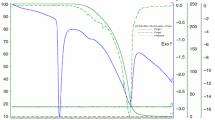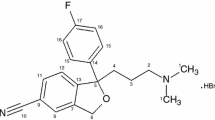Abstract
First-line drugs (rifampicin, RIF; isoniazid, INH; ethambutol, ETA; and pyrazinamide, PZA) recommended in conventional treatment of tuberculosis were analyzed in 1:1 w/w binary mixtures with microcrystalline cellulose MC 101 (CEL) and lactose supertab® (LAC) by differential scanning calorimetry (DSC), thermogravimetry (TG), differential thermal analysis (DTA), and Fourier transformed infrared analysis (FTIR) as part of development of fixed dose combination (FDC) tablets. Evidence of interaction between drug and pharmaceutical excipients was supposed when peaks disappearance or shifting were observed on DTA and DSC curves, as well as decreasing of decomposition temperature onset and TG profiles, comparing to pure species data submitted to the same conditions. LAC was showed to interact with RIF (absence of drug fusion and recrystallization events on DSC/DTA curves); INH (thermal events of the mixtures different from those observed for drug and excipient pure in DSC/DTA curves); PZA (decrease on drug fusion peak in DSC/DTA curves), and ETA (shift on drug onset fusion and absence of pure LAC events on DSC/DTA curves). In all cases, an important decrease on the temperature of drug decomposition was verified for the mixtures (TG analysis). However, FTIR analysis showed good correlation between theoretical and experimental drug-LAC spectra except for INH–LAC mixture, evidencing high incompatibility between these two species and suggesting that those interactions with PZA and RIF were thermally induced. No evidence of incompatibilities in CEL mixtures was observed to any of the four-studied drugs.



Similar content being viewed by others
References
World Health Organization. WHO report 2011. Global tuberculosis control. Geneva, Switzerland: World Health Organization. 2011. http://www.who.int/tb/publications/global_report/2011/gtbr11_full.pdf. Accessed 11 May 2012.
World Health Organization. Fixed-dose combination tablets for the treatment of tuberculosis: report of an informal meeting held in Geneva Tuesday, 27 April 1999. World Health Organization, Communicable Diseases Cluster, 1999. http://www.emro.who.int/stb/media/pdf/fdc.pdf. Accessed 11 May 2012.
Singh S, Bhutani H, Mariappan TT. Quality problems of anti-tuberculosis fixed-dose combinations (FDCs): a way forward. Indian J of tuberculosis. 2006;5:201–5.
Ahmad Md Z, Kumar V, Kumar A, Akhter S. Drug-excipients interactions and compatibility study: a review. J Pharm Res. 2010;3:2092–209.
DiFeo TJ. Drug product development: a technical review of chemistry, manufacturing, and controls information for the support of pharmaceutical compound licensing activities. Drug Dev Ind Pharm. 2003;29:939–58.
Giron D. Contribution of thermal methods and related techniques to the rational development of pharmaceuticals—part 2. Pharm Sci Technol Today. 1998;6:262–8.
Lavor EP, Freire FD, Aragão CFS, Raffin FN, de Lima e Moura TFA. Application of thermal analysis to the study of anti-tuberculosis drug compatibility: part I. J Therm Anal Calorim. 2011. doi:10.1007/10973-01101770-8.
Bernardi LS, Oliveira PR, Murakami FS, Silva MAS, Borgmann SHM. Characterization of venlafaxine hydrochloride and compatibility studies with pharmaceutical excipients. J Therm Anal Calorim. 2009;97:729–33.
Pinto MA, de Moura EA, de Souza FS, Macêdo RO. Thermal compatibility studies of nitroimidazoles and excipients. J Therm Anal Calorim. 2010;102:323–9.
Freire FD, Aragão CFS, de Lima e Moura TFA, Raffin FN. Compatibility study between chlorpropamide and excipients in their physical mixtures. J Therm Anal Calorim. 2009;97:355–7.
Tomassetti M, Catalani A, Rossi V, Vecchio S. Thermal analysis study of the interactions between acetaminophen and excipients in solid dosage forms and in some binary mixtures. J Pharm Biomed Anal. 2005;37:949–55.
Giron D. Applications of thermal analysis in the pharmaceutical industry. J Pharm Biomed Anal. 1986;4:755–70.
Salvio Neto H, Novák CS, Matos JR. Thermal analysis and compatibility studies of prednicarbate with excipients used in semi solid pharmaceutical form. J Therm Anal Calorim. 2009;97:367–74.
Mura P, Faucci MT, Manderioli A, Bramanti G, Ceccarelli L. Compatibility study between ibuproxam and pharmaceutical excipients using differential scanning calorimetry, hot-stage microscopy and scanning electron microscopy. J Pharm Biomed Anal. 1998;18:151–63.
Cides LCS, Araújo AAS, Santos-Filho M, Matos JS. Thermal behaviour, compatibility study and decomposition kinetics of glimepiride under isothermal and non-isothermal conditions. J Therm Anal Calorim. 2006;84:441–5.
Shan-Yang L, Shun-Li W. Advances in simultaneous DSC–FTIR microspectroscopy for rapid solid-state chemical stability studies: some dipeptide drugs as examples. Adv Drug Deliv Rev. 2012;64:461–78.
Nasrazadani S. Review of applications of Fourier transform infrared spectrophotometry (FTIR) in characterization of construction materials. In: Geo-Frontiers 2011 ASCE 2011. 2011. http://scitation.aip.org/getpdf/servlet/GetPDFServlet?filetype=pdf&id=ASCECP000397041165000466000001&idtype=cvips&doi=10.1061/41165(397)466&prog=normal. Assessed 15 May 2012.
Duygu D, Baykal T, Açikgöz İ, Yildiz K. Fourier transform infrared (FT-IR) spectroscopy for biological studies. Gazi Univ J Sci. 2009;22(3):117–21.
Lerdkanchanaporn S, Dollimore D, Alexander KS. A simultaneous TG–DTA study of the degradation in nitrogen of cellulose to carbon, alone and in the presence of other pharmaceutical excipients. Thermochim Acta. 1998;324:25–32.
Rowe RC, Sheskey PJ, Weller P. Handbook of pharmaceutical excipients. 4th ed. London: The Royal Pharmaceutical Society of Great Britain and The American Pharmaceutical Association; 2003.
Santos AFO, Basílio ID Jr, Souza FS, Medeiros AFD, Pinto MF, Santana DP. Application of thermal analysis of binary mixtures with metformin. J Therm Anal Calorim. 2008;93:361–4.
Bharate SS, Bharate SB, Bajaj AN. Interactions and incompatibilities of pharmaceutical excipients with active pharmaceutical ingredients: a comprehensive review. J Excip Food Chem. 2010;1(3):3–25.
Acknowledgments
The authors acknowledge to Universidade Federal do Rio Grande do Norte, UFRN and Coordenacao de Aperfeicoamento de Pessoal de Nivel Superior, CAPES, for a fellowship Master Science.
Author information
Authors and Affiliations
Corresponding author
Rights and permissions
About this article
Cite this article
Lavor, E.P., Navarro, M.V.M., Freire, F.D. et al. Application of thermal analysis to the study of antituberculosis drugs–excipient compatibility. J Therm Anal Calorim 115, 2303–2309 (2014). https://doi.org/10.1007/s10973-013-3050-2
Received:
Accepted:
Published:
Issue Date:
DOI: https://doi.org/10.1007/s10973-013-3050-2




